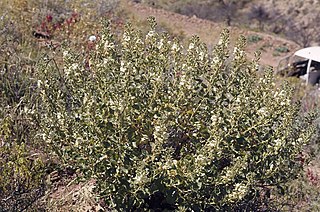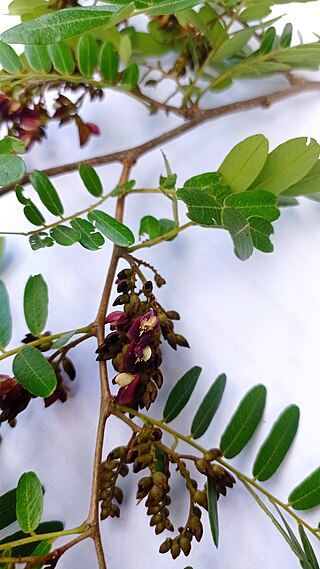
The International Union for Conservation of Nature (IUCN) Red List of Threatened Species, also known as the IUCN Red List or Red Data Book, founded in 1964, is an inventory of the global conservation status and extinction risk of biological species. A series of Regional Red Lists, which assess the risk of extinction to species within a political management unit, are also produced by countries and organizations.

Rosewood is any of a number of richly hued hardwoods, often brownish with darker veining, but found in other colours. It is hard, tough, strong, and dense. True rosewoods come from trees of the genus Dalbergia, but other woods are often called rosewood. Rosewood takes a high polish and is used for luxury furniture-making, flooring, musical instruments, and turnery.

Morpho peleides, the Peleides blue morpho, common morpho or the emperor is an iridescent tropical butterfly found in Mexico, Central America, northern South America, Paraguay and Trinidad. Most authorities believe that peleides is a subspecies of Morpho helenor.

A species that is extinct in the wild (EW) is one that has been categorized by the International Union for Conservation of Nature as only consisting of living members kept in captivity or as a naturalized population outside its historic range. Classification requires exhaustive surveys conducted within the species' known habitat with consideration given to seasonality, time of day, and life cycle. Once a species is classified as EW, the only way for it to be downgraded is through reintroduction.

Dalbergia nigra, commonly known as the Bahia rosewood, jacarandá-da-Bahia, Brazilian rosewood, Rio rosewood, jacarandá-do-brasil, pianowood, caviúna, graúna, jacarandá-una or obuina is a species of legume in the family Fabaceae.

Machaerium is a genus of flowering plants in the family Fabaceae, and was recently assigned to the informal monophyletic Dalbergia clade of the Dalbergieae. It contains the following species:
Machaerium cirrhiferum, the espuela de gallo or espuela de gato, is a species of flowering plant in the family Fabaceae. It is found in Colombia, Costa Rica, Mexico, and Panama.
Machaerium cuzcoense is a species of flowering plant in the family Fabaceae. It is found only in Peru.
Machaerium glabripes is a species of flowering plant in the family Fabaceae. It is found only in Panama.
Machaerium nicaraguense is a species of flowering plant in the family Fabaceae. It is found in El Salvador, Guatemala, Honduras and Nicaragua.

Machaerium villosum, the jacarandá-do-cerrado, jacarandá-pardo, jacarandá-paulista, or jacarandá-pedra, is a native tree belonging to the Fabaceae family, primarily in Brazil. These trees preferably grown on the Cerrado and Caatinga, but they can also inhabit the Atlantic Forest. They are currently vulnerable due to logging and, primarily, habitat loss for agriculture and livestock.

Morpho achilles, the Achilles morpho, blue-banded morpho, or banded blue morpho, is a Neotropical butterfly.

Machaerium nyctitans, also known as canela do brejo or espuela de gallo, is a tree species in the family Fabaceae, native to Brazil and Argentina.
Machaerium is a genus of flies in the family Dolichopodidae. It is distributed in the Western Palaearctic, with a single record from Tanzania in the Afrotropics.

Physaria chambersii is a species of flowering plant in the family Brassicaceae known by the common name Chambers' twinpod. It is native to the southwestern United States, where it grows in desert woodland and plateau habitat. It is a perennial herb growing from a taproot and producing a clumpy rosette of stems up to 15 centimeters long, growing erect and falling over in fruit. The plant is covered in a silver-white coat of hairs. The leaves in the rosette are rounded to oval, up to 6 centimeters long by 2 wide, and smaller, spoon-shaped leaves are located along the stems. The inflorescence is a raceme of four-petalled golden yellow flowers. The fruit is an inflated pod which may be over a centimeter long. It is notched and divided into two chambers, each containing 4 seeds.
Pau ferro is a common name for several trees and may refer to:

The Guianan piedmont and lowland moist forests (NT0182) is an ecoregion in the south of Venezuela and the north of Brazil. It is in the Amazon biome. The ecoregion is relatively intact, largely protected by conservation units or indigenous territories, and less threatened by global warming than flatter and more deforested regions.

Endangered species, as classified by the International Union for Conservation of Nature (IUCN), are species which have been categorized as very likely to become extinct in their known native ranges in the near future. On the IUCN Red List, endangered is the second-most severe conservation status for wild populations in the IUCN's schema after critically endangered. In 2012, the IUCN Red List featured 3,079 animal and 2,655 plant species as endangered worldwide. The figures for 1998 were 1,102 and 1,197 respectively.

Goodenia chambersii is a species of flowering plant in the family Goodeniaceae and is endemic to South Australia. It is an ascending shrub with toothed, broadly egg-shaped to round leaves, racemes or thyrses of yellow flowers and oval fruit.

Machaerium scleroxylon is a species of tree in the family Fabaceae Common names for the species include: pau ferro, morado, caviuna, Bolivian rosewood, and Santos rosewood. The wood is used as an alternative species to genuine rosewoods belonging to the genus Dalbergia.














